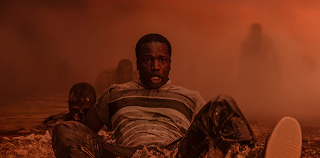Stirring, hair-raising "His House" marries immigration and spooks
His House (2020)
Just when we thought the haunted house sub-genre dried up all of its real estate comes “His House,” the stirring directorial debut of Remi Weekes. What if bumps in the night were intrinsically tied to the trauma of living in a war-torn country and seeking asylum? Weekes marries the immigrant experience and paranormal activity, never allowing his blend of existential and supernatural hauntings to feel heavy-handed or tasteless. Confidently steering the wheel without fully reinventing it, Weekes builds a haunted asylum out of shared grief and survivor’s guilt with empathy and hair-raising tension. As a repurposed social-issues ghost story, “His House” makes a case that the horror genre can be open and specific to other cultures and still hit hard.
Bol (Sopé Dìrísù) and Rial Majur (Wunmi Mosaku) are husband-and-wife refugees from South Sudan. Fleeing their war-torn village and crossing the ocean but losing their daughter along the way, they are placed in a U.K. detention facility before being granted a low-income housing opportunity. Not yet citizens, they are released on bail as asylum seekers and set up by a social worker, Mark (Matt Smith), in a squalid but spacious residence in an unfriendly slum neighborhood. Never mind the cockroaches and rotting walls and the list of conditions they must follow, Bol and Rial promise to adapt, as they are ready to build a new life of normalcy as much as they can. Besides the hostility that resides outside, the couple begin to experience something in the walls that has followed them from Sudan.
From a story by Felicity Evans and Toby Venables and the script written and directed by Remi Weekes, “His House” is not one of those frustrating haunted-house movies where the easiest answer to a family’s supernatural troubles is to just get out of Dodge. If the first “Insidious” film cleverly figured out a way around that blind spot in logic, Weekes’ screenplay pulls off a solution, too, with additional real-world heft. For very good reasons, Bol and Rial can’t afford to leave, or they will have to re-face another stint in the detention facility or be forced back to their country. Bol and Rial are good people—and grateful—and yet they do not face the most warm welcome inside or outside. When Rial ventures out of their new home to see the doctor and gets lost, she stops to ask a trio of Black British punks for directions, only to get contradictory answers and then an aggressively xenophobic indignity, “Go back to Africa!” Meanwhile, when Bol walks into a department store for some new clothing and tries basing his wardrobe on a billboard with a white man in a polo neck shirt, he is immediately followed by security. Even when Bol does report to Mark about moving due to vermin, he is rejected and reminded by other council workers that Bol’s house is bigger than theirs.
Standing strong next to Iranian filmmaker Barak Anvari’s 2016 debut “Under the Shadow,” in which a djinn haunts a mother and daughter in war-torn Tehran, “His House” packs a layered punch with its international specificity and the withholding of the characters’ shared sins like a skeleton in the wall. The film draws from Dinka folklore, particularly an “apeth”—or a night witch—that has found Bol and Rial to have them atone for their sins. (The Witch is chillingly played by none other than Javier Botet, the genre’s go-to spectral chameleon.) Once the source of the characters’ guilt-stricken grief is understood in the last fifteen minutes that weave between reality, memories, and a nightmarish plane, Bol and Rial are cast in a different, albeit even more nuanced, light. This recontextualization humanizes them even more without painting them as villains.
As the title of “His House” implies, the power changes from start to finish, but the ghosts from Bol and Rial’s past will never leave. Sopé Dìrísù and Wunmi Mosaku are outstanding as Bol and Rial, particularly Mosaku, authentically conveying the inner turmoil that often goes unspoken between them. While Dìrísù’s Bol is the one driven mad as he tears down the wallpaper and knocks holes in the walls, Mosaku’s still-grieving Rial remains the more resilient one. When either character is terrified, we can’t blame them. Remi Weekes expertly builds the creeping scare sequences into the story, sparingly providing jump scares with light-switch magic tricks and rotting-face peekaboo. The nightmares plaguing Bol of crossing the ocean and being tormented by the “apeth” are also strikingly visualized by cinematographer Jo Willems, particularly in a dinner scene where Bol ends up still at his kitchen table floating in the clay-orange hued sea. Freaky and fraught with equal spooks and real-world anxieties, “His House” locates catharsis and subjective unfamiliarity in a familiar blueprint.
Grade: B +
Netflix released “His House” (93 min.) for streaming on October 30, 2020.













Comments
Post a Comment